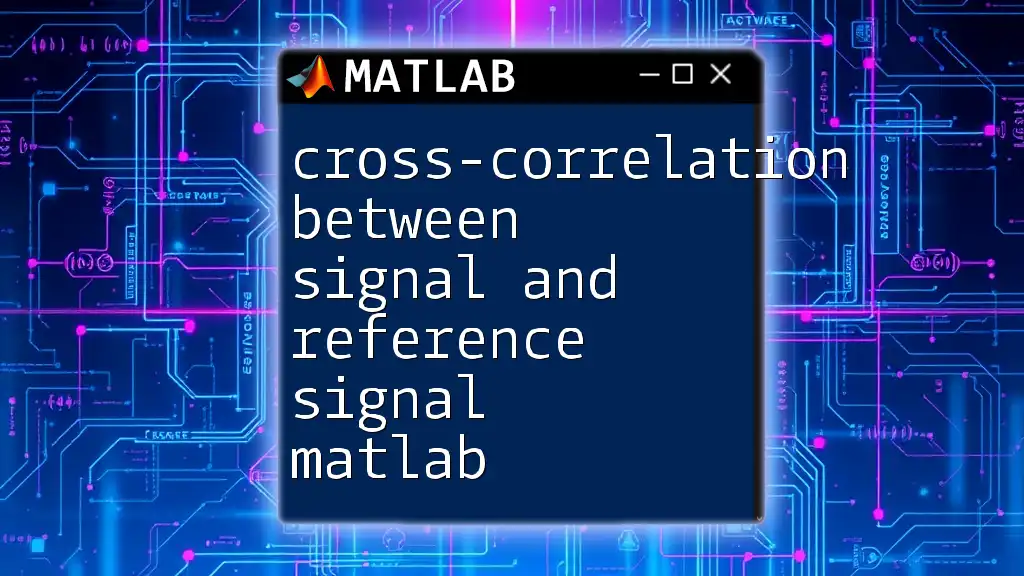Cross-correlation in MATLAB is a technique used to measure the similarity between two signals as a function of the time-lag applied to one of them, and can be easily computed using the `xcorr` function.
Here’s a simple code snippet to demonstrate cross-correlation for two signals:
% Define two signals
x = [1, 2, 3, 4, 5];
y = [2, 3, 4];
% Compute cross-correlation
[c, lags] = xcorr(x, y);
% Display the results
disp('Cross-correlation:');
disp(c);
disp('Lags:');
disp(lags);
Understanding Cross Correlation
What is Cross Correlation?
Cross correlation is a statistical method that measures the similarity between two signals as a function of the time-lag applied to one of them. It is widely used in signal processing, time series analysis, and various engineering disciplines to detect the presence of a known signal within another signal.
Difference between Autocorrelation and Cross Correlation
While autocorrelation measures how a single signal is correlated with itself over time, cross correlation assesses the relationship between two distinct signals. This distinction is essential in applications such as feature detection, where you may want to determine how one signal is aligned with another.
Mathematical Representation
The mathematical formula for cross correlation can be represented as:
\[ R_{xy}(\tau) = \sum_{t} x(t) \cdot y(t + \tau) \]
Here, \( R_{xy}(\tau) \) signifies the cross correlation between signals \( x \) and \( y \), and \( \tau \) is the time lag. Breaking down this formula helps in understanding each term’s role: \( x(t) \) is evaluated against \( y(t + \tau) \), which indicates that the values of \( y \) are shifted by \( \tau \).
Applications of Cross Correlation
Signal Processing
In signal processing, cross correlation plays a crucial role in the detection of signals buried in noise. For example, it helps in identifying the presence of a specific waveform within a recorded signal.
Time Series Analysis
In finance and economics, cross correlation can reveal relationships between different time series, assisting in understanding market dynamics and forecasting trends.
Image Processing
Cross correlation techniques are vital for image processing applications, such as feature matching, where the goal is to identify the same features in different images.

Using Cross Correlation in MATLAB
MATLAB Built-in Functions
One of the principal functions used for cross correlation in MATLAB is the `xcorr` function. Its syntax is as follows:
Rxy = xcorr(x, y)
Basic Usage of xcorr
To demonstrate basic cross correlation, consider this simple example:
% Simple Cross-Correlation Example
x = [1, 2, 3, 4, 5];
y = [2, 3, 4];
Rxy = xcorr(x, y);
disp(Rxy);
In this code snippet, we define two vectors, `x` and `y`, and compute their cross correlation with `xcorr`. The display function `disp(Rxy);` outputs the result, which shows how `x` is related to `y` across various lags.
Interpreting the Output
The output from `xcorr` is an array that contains the cross correlation values for various lags. By exploring these values, you can comprehend the degree of correlation between the two signals as they shift relative to each other.
Advanced Usage of xcorr
Normalizing Cross Correlation
Normalizing cross correlation is crucial when comparing signals of different amplitudes. Normalization adjusts for differences in signal scales, allowing for a more accurate similarity assessment. You can normalize your result with the following code:
Rxy_normalized = Rxy / (norm(x) * norm(y));
Visualizing Cross Correlation
Visualization is a powerful method to understand cross correlation results better. You can create plots in MATLAB to see how the correlation varies with lag. Here's a sample code snippet for visualization:
% Cross-Correlation Visualization
[c, lags] = xcorr(x, y);
stem(lags, c);
xlabel('Lags');
ylabel('Cross-Correlation');
title('Cross-Correlation of x and y');
This plot offers a clear representation of the cross correlation, with lags along the x-axis and correlation values on the y-axis.

Practical Applications
Using Cross Correlation to Find Delays
Estimating time delays between two signals is a fundamental application of cross correlation. Consider the following scenario using MATLAB:
% Delay Estimation
[c, lags] = xcorr(x, y);
[~, I] = max(abs(c)); % Finding index of max correlation
time_delay = lags(I);
disp(['Estimated time delay: ', num2str(time_delay)]);
In this example, we calculate the cross correlation and identify the position of the maximum correlation value. The resultant `time_delay` informs us of how much one signal is offset from the other.
Cross Correlation in Feature Matching
Cross correlation is invaluable in the realm of image processing for feature matching. For a basic implementation, you can utilize the following code snippet:
img1 = imread('image1.png');
img2 = imread('image2.png');
c = normxcorr2(img1, img2); % Perform normalized cross-correlation
This example demonstrates how to apply normalized cross correlation to two images, allowing for feature matching based on their content.

Tips and Best Practices
Choosing Appropriate Window Sizes
When computing cross correlation, it is important to consider the window size. If the window is too small, significant information may be lost, whereas a window that is too large can introduce noise and irrelevant data. The optimal size typically depends on the objective of your analysis.
Handling Noisy Data
In the presence of noise, preprocessing your signals through filtering techniques can significantly improve the accuracy of cross correlation results. Common approaches include using median or low-pass filters to smooth out the signals before analysis.
Performance Considerations
For large datasets, efficiency becomes a major concern when conducting cross correlation. MATLAB has functions optimized for performance; consider using these alongside parallel computing resources for processing extensive data efficiently.

Conclusion
In conclusion, cross correlation in MATLAB provides powerful techniques for analyzing and interpreting the relationships between different signals. By understanding its mathematical foundation, utilizing built-in functions like `xcorr`, and applying practical applications, you are well-equipped to explore a variety of domains where cross correlation is relevant.
Additional Resources
For more advanced studies, you may explore MATLAB's official documentation, join online forums, or engage in community discussions. These platforms are valuable for sharing knowledge and addressing queries related to cross correlation and its diverse applications in MATLAB.

















